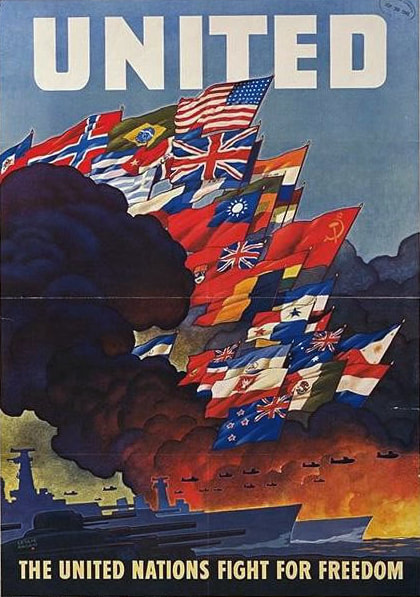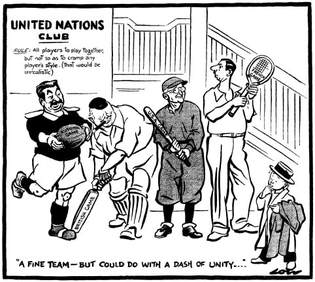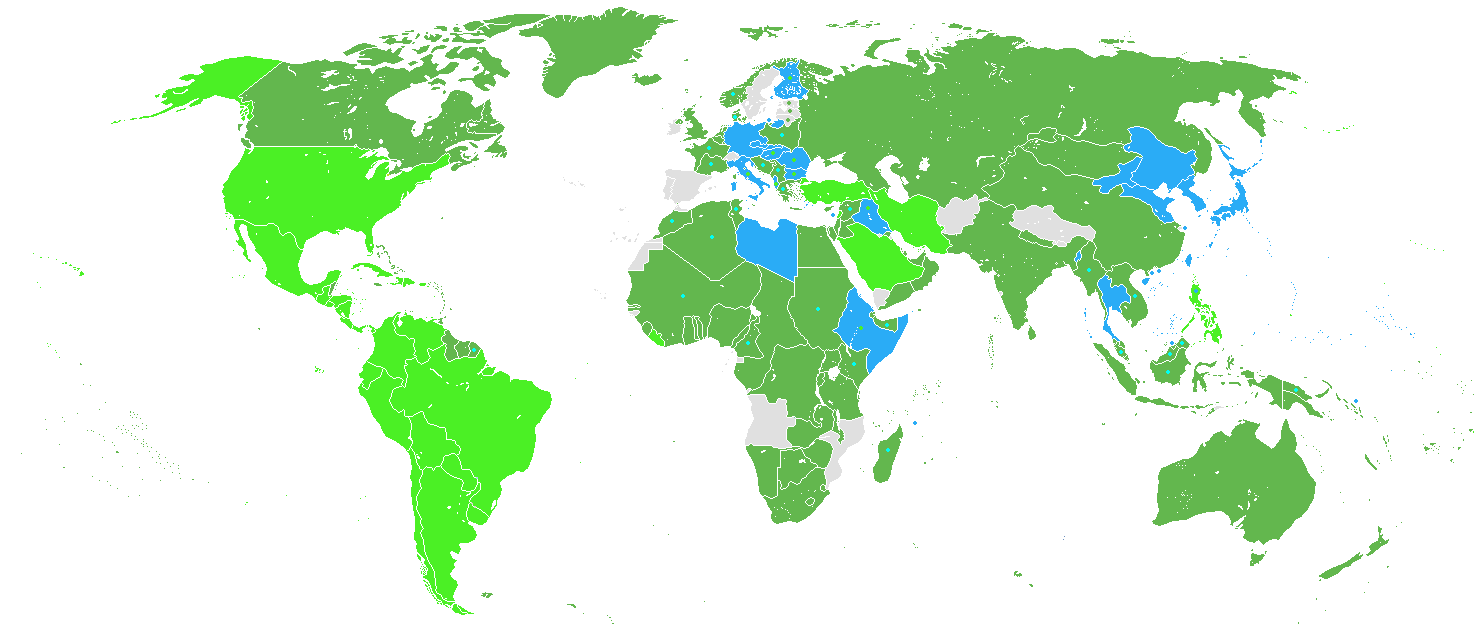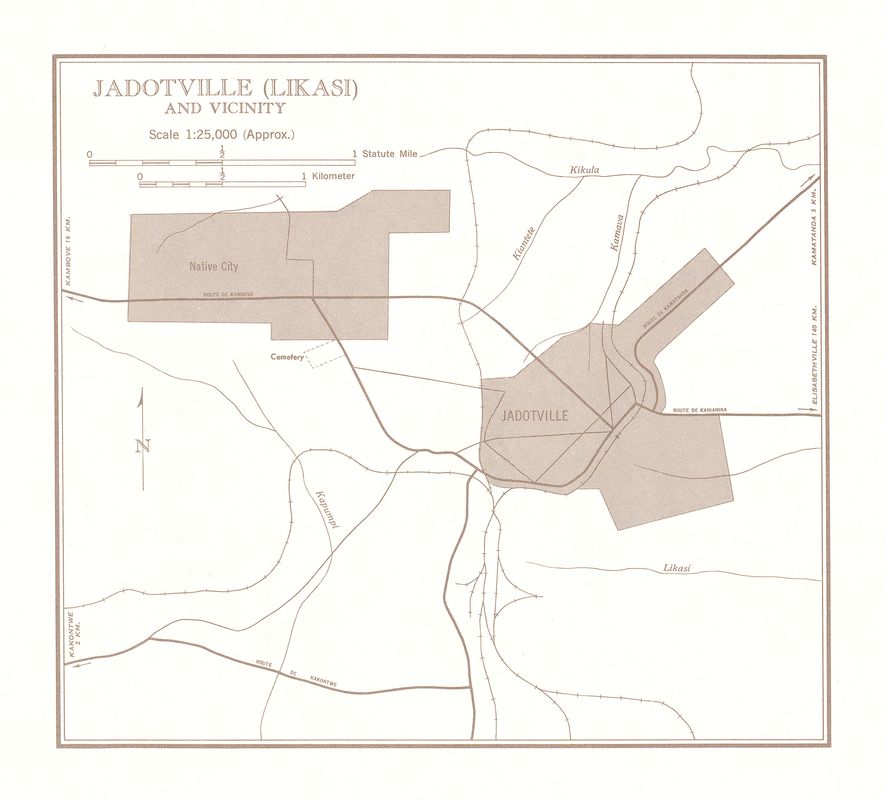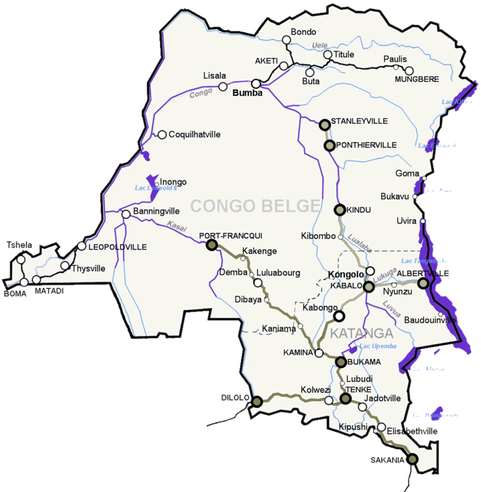
United Nations Declaration: The complete alliance thus effected was in the light of the principles of the Atlantic Charter, and the first clause of the United Nations Declaration reads that the signatory nations had:
" . . .subscribed to a common program of purposes and principles embodied in the Joint Declaration of the President of the United States of America and the Prime Minister of the United Kingdom of Great Britain and Northern Ireland dated August 14, 1941, known as the Atlantic Charter ". The eight principal points of the Charter were:
|
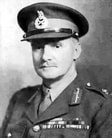 General Sir Frank Messervy, First Commander-in-Chief of Pakistan Army 1947-48)
General Sir Frank Messervy, First Commander-in-Chief of Pakistan Army 1947-48)
Map of Participants in World War II:
Their first Diplomatic Event - Armistice with Italy
In August 1943, Smith and Strong flew to Lisbon in Portugal covertly, where they met with General Guiseppe Castellano (representing the State of Italy)at the British embassy. Castellano had hoped to arrange terms for Italy to join the United Nations against Nazi Germany, Smith was empowered to draw up an armistice only, but he was unable to negotiate political matters. On September 3, Smith and Castellano signed the agreed-upon text on behalf of Eisenhower and Pietro Badoglio (Prime Minister of Italy), respectively, in a simple ceremony beneath an olive tree at Cassibile, Sicily. Italy joined the United Nations on 10th October 1943.
When the armistice was announced by Allied radio, on the afternoon of 8 September, German forces immediately attacked Italian forces by executing Operation Asche; the majority of the Italian Army had not been informed about the armistice and no clear orders had been issued about the line of conduct to be taken in the face of the German armed forces. In the meanwhile the Italian troops, without instructions, collapsed and were soon overwhelmed, and some small units decided to stay loyal to the German ally. Between 8 and 12 September, German forces therefore occupied all of the Italian territory still not under Allied control except Sardinia and part of Apulia, without meeting great organized resistance.
The slow push up the spine of Italy followed its tortuous path against a stubborn and often entrenched foe. Of course following the Armistice and later Peace with Italy there followed the collapse & surrender of both Nazi Germany and Imperial Japan and the the formation of an enlarged and peace-orientated United Nations.
Post WW2
In 1947 The UN allocated US & British military forces to protect the Free Territory of Trieste ( a result of the peace with Italy)
The first peace keeping missions were during the Indo-Pakistan War of 1947 and Arab Israeli War of 1948.
The Indo-Pakistan is relatively easy to re-fight using miniatures as both combatants were initially militia units reinforced by regular units of both sides (the Pakistani Army being frequently commanded by British Army officers including the CinC) which had been the British Indian Army only months previously therefore equipment on both sides was effectively late WW2 British.
The Korean War commenced on 25th June 1950 and continued for three bloody years and was the first real test of the United Nations as it upheld its charter. From a wargaming perspective the Korean War is not a popular period, however it does have interesting possibilities on land, at sea and in the air. Ground troops were predominantly still armed in the WW2 fashion, with some new innovations and equipment and in the air we have combat between piston-engined aircraft as well as the famous duels between F-86 Sabres and Mig-15s.
Organisation des Nations Unies au Congo, abbreviated ONUC (English: United Nations Organization in the Congo) commenced in 1960 to bring order to the former Belgian colony after independence. A multi-national force was sent comprising of Irish, Canadian, Malaysian & Swedish contingents as well as Ghanaian, Nigerian, and Indian troops.
A number of serious combat actions took place including the 4-day Battle of the Tunnel and the 5-day Seige of Jadotville which involved the ill-equipped Irish Army contingent defending against a massive rebel force (there is a good movie on the seige). 158 Irish soldiers defended against an enemy strength of approx 4,000 men of the Front for Congolese National Liberation, but also many Belgian, French, and Rhodesian veteran mercenaries armed with a mix of light weapons and 81mm mortars. The attacking force also had air support in the form of a Fouga Magister trainer jet fitted with underwing bombs and machine guns. The Irish UN soldiers had, for the most part, only light personal weapons and a small number of water-cooled Vickers machine guns & 60mm mortars. And there was a relief force too!
A number of days into the siege the Irish radioed to their headquarters: "We will hold out until our last bullet is spent. Could do with some whiskey"
Air cover was provided by Swedish J 29B jets (available in 1/200th & 1/285th scales from Shapeways) that performed well in Theatre.
- Dark Green: Allies before the Japanese attack on Pearl Harbor, including colonies and occupied countries.
- Light Green: Allied countries that entered the war after the attack on Pearl Harbor.
- Blue: Axis Powers and their colonies or countries that had to choose a side in order to stay independent.
- Grey: Neutral countries during WWII
- Dark green dots represent countries that initially were neutral but during the war were annexed by the USSR
- Light green dots represent countries that later in the war changed from the Axis to the Allies
- Blue dots represent countries either being conquered by the Axis Powers, becoming puppets of those (Vichy France and several French colonies).
- United States (from December 1941)
- Soviet Union (from June 1941)
- United Kingdom
- China
Their first Diplomatic Event - Armistice with Italy
In August 1943, Smith and Strong flew to Lisbon in Portugal covertly, where they met with General Guiseppe Castellano (representing the State of Italy)at the British embassy. Castellano had hoped to arrange terms for Italy to join the United Nations against Nazi Germany, Smith was empowered to draw up an armistice only, but he was unable to negotiate political matters. On September 3, Smith and Castellano signed the agreed-upon text on behalf of Eisenhower and Pietro Badoglio (Prime Minister of Italy), respectively, in a simple ceremony beneath an olive tree at Cassibile, Sicily. Italy joined the United Nations on 10th October 1943.
When the armistice was announced by Allied radio, on the afternoon of 8 September, German forces immediately attacked Italian forces by executing Operation Asche; the majority of the Italian Army had not been informed about the armistice and no clear orders had been issued about the line of conduct to be taken in the face of the German armed forces. In the meanwhile the Italian troops, without instructions, collapsed and were soon overwhelmed, and some small units decided to stay loyal to the German ally. Between 8 and 12 September, German forces therefore occupied all of the Italian territory still not under Allied control except Sardinia and part of Apulia, without meeting great organized resistance.
The slow push up the spine of Italy followed its tortuous path against a stubborn and often entrenched foe. Of course following the Armistice and later Peace with Italy there followed the collapse & surrender of both Nazi Germany and Imperial Japan and the the formation of an enlarged and peace-orientated United Nations.
Post WW2
In 1947 The UN allocated US & British military forces to protect the Free Territory of Trieste ( a result of the peace with Italy)
The first peace keeping missions were during the Indo-Pakistan War of 1947 and Arab Israeli War of 1948.
The Indo-Pakistan is relatively easy to re-fight using miniatures as both combatants were initially militia units reinforced by regular units of both sides (the Pakistani Army being frequently commanded by British Army officers including the CinC) which had been the British Indian Army only months previously therefore equipment on both sides was effectively late WW2 British.
The Korean War commenced on 25th June 1950 and continued for three bloody years and was the first real test of the United Nations as it upheld its charter. From a wargaming perspective the Korean War is not a popular period, however it does have interesting possibilities on land, at sea and in the air. Ground troops were predominantly still armed in the WW2 fashion, with some new innovations and equipment and in the air we have combat between piston-engined aircraft as well as the famous duels between F-86 Sabres and Mig-15s.
Organisation des Nations Unies au Congo, abbreviated ONUC (English: United Nations Organization in the Congo) commenced in 1960 to bring order to the former Belgian colony after independence. A multi-national force was sent comprising of Irish, Canadian, Malaysian & Swedish contingents as well as Ghanaian, Nigerian, and Indian troops.
A number of serious combat actions took place including the 4-day Battle of the Tunnel and the 5-day Seige of Jadotville which involved the ill-equipped Irish Army contingent defending against a massive rebel force (there is a good movie on the seige). 158 Irish soldiers defended against an enemy strength of approx 4,000 men of the Front for Congolese National Liberation, but also many Belgian, French, and Rhodesian veteran mercenaries armed with a mix of light weapons and 81mm mortars. The attacking force also had air support in the form of a Fouga Magister trainer jet fitted with underwing bombs and machine guns. The Irish UN soldiers had, for the most part, only light personal weapons and a small number of water-cooled Vickers machine guns & 60mm mortars. And there was a relief force too!
A number of days into the siege the Irish radioed to their headquarters: "We will hold out until our last bullet is spent. Could do with some whiskey"
Air cover was provided by Swedish J 29B jets (available in 1/200th & 1/285th scales from Shapeways) that performed well in Theatre.
